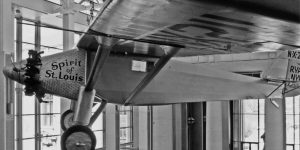What Happened On May 20th?
On May 20, 1927, in the early morning hours at Roosevelt Field, New York, Charles Lindbergh began an audacious journey.
At precisely 7:52 AM, the Spirit of St. Louis, a single-engine monoplane, took off from a rain-soaked runway. Its pilot aimed to become the first person to complete a solo non-stop transatlantic flight from New York to Paris.
As the aircraft ascended, its heavy load of 450 gallons of fuel made the takeoff perilous, barely clearing the telephone wires at the end of the runway. Lindbergh’s flight was a daring venture into the unknown, fraught with potential hazards.
Facing The Unknown
Lindbergh faced numerous challenges during his 33-and-a-half-hour flight. The most immediate was the weight of the fuel-laden aircraft. The Spirit of St. Louis was designed to carry a great amount of fuel to cover the 3,600 miles across the Atlantic. This required a delicate balance along with exceptional piloting skills to ensure the plane lifted off successfully without crashing back onto the runway.
Once airborne, Lindbergh confronted the relentless elements. He flew through thick fog, icy conditions, and violent storms, with nothing but basic navigation instruments and a magnetic compass to guide him.

The cockpit of the Spirit of St. Louis was so small that Lindbergh could not even stretch his legs, and the plane lacked a front windshield. Instead, he relied on a periscope to see ahead, a design choice made to reduce weight and increase fuel efficiency.
Battling Exhaustion
Fatigue was another formidable adversary. Lindbergh had to stay awake and be alert for the entire duration of the flight, battling drowsiness and hallucinations. To stave off sleep, he resorted to flying at low altitudes, hoping that the chill of the ocean spray would help keep him awake. He also held his eyelids open with his fingers and periodically snapped himself with a rubber band. At one point, he felt he was surrounded by ghostly apparitions, a testament to the severe strain on his mind and body.
Near Disaster
Interestingly, Lindbergh almost didn’t make the flight. Just days before his departure, he experienced a near-fatal crash during a test flight in the Spirit of St. Louis. Fortunately, he escaped uninjured, but the incident underscored the inherent risks of his venture.
Triumph In Paris
Despite these daunting obstacles, Lindbergh successfully navigated his way across the Atlantic, landing at Le Bourget Field near Paris at 10:22 PM on May 21, 1927. He was greeted by a frenzied crowd of over 100,000 people, all eager to catch a glimpse of the daring young aviator who had just accomplished the seemingly impossible.

Lindbergh’s Spirit of St. Louis was custom-built by Ryan Airlines in San Diego, California, in just 60 days. The plane’s design included several innovative features to maximize fuel efficiency and range, but it also had notable limitations, such as the lack of a radio and the rudimentary navigation equipment.
Unthinkable Tragedy
However, Lindbergh’s life would later be overshadowed by a tragic event. Five years after his historic flight, on March 1, 1932, Charles Lindbergh Jr., the 20-month-old son of Charles and Anne Morrow Lindbergh, was abducted from the family’s home in Hopewell, New Jersey. The kidnapping was a harrowing ordeal that led to one of the most intense manhunts in American history.
The toddler was taken from his nursery on the second floor of the Lindbergh home, and a ransom note demanding $50,000 was left on the windowsill. Despite the Lindberghs paying the ransom, the child was found dead over two months later, in a wooded area not far from the family’s home. The tragic death of the Lindbergh baby led to the passage of the “Lindbergh Law,” which made kidnapping a federal offense in the United States.
Nevertheless, Charles Lindbergh’s solo transatlantic flight remains to be one of the most remarkable feats in aviation history. The challenges he faced and overcame during the journey tested his skill, determination, and spirit.





